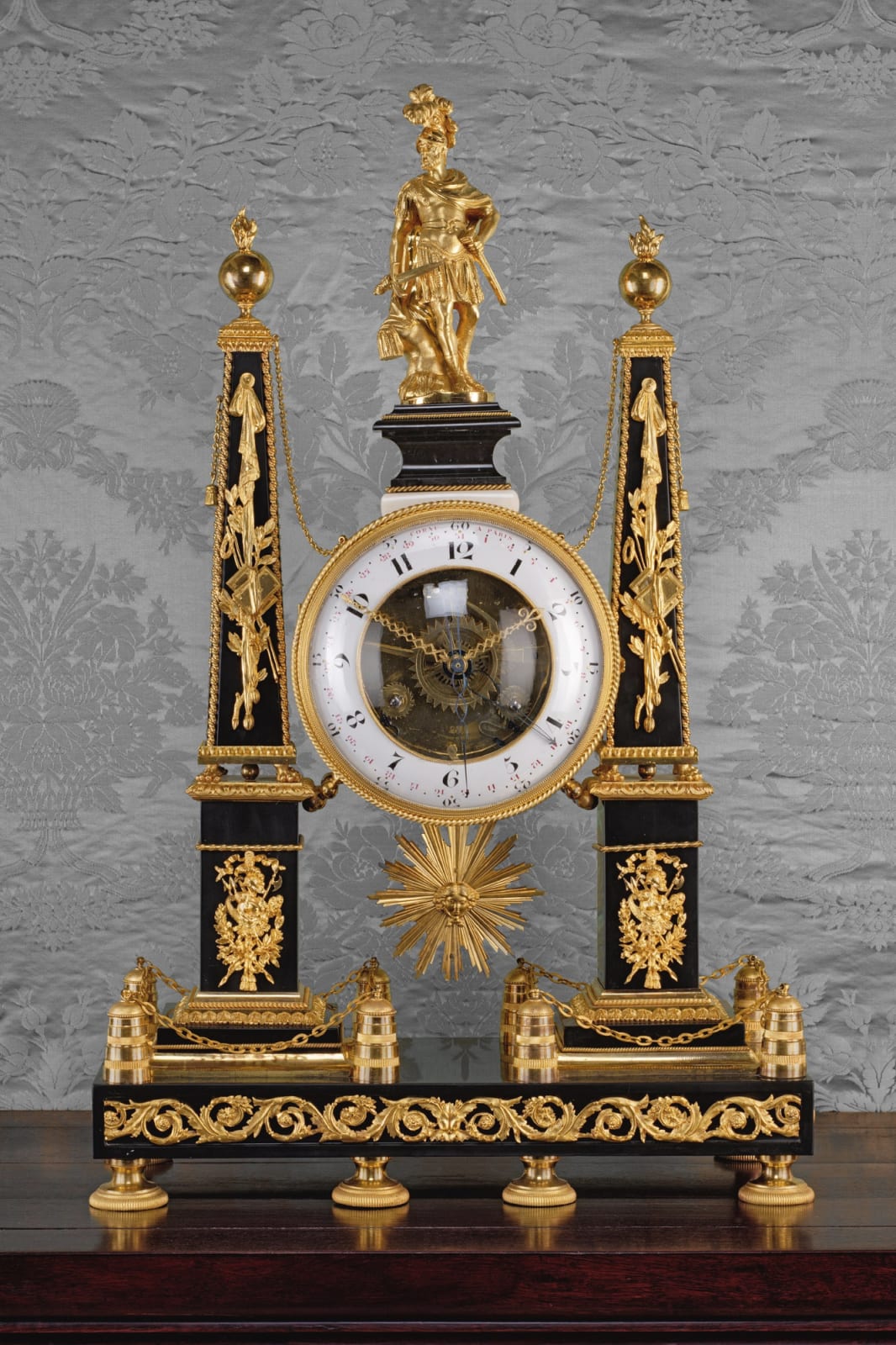Unknown
Literature
Pierre Kjellberg, “Encyclopédie de la Pendule Française du Moyen Age au XXe Siècle”, 1997, p. 204, pl. E, illustrating a clock with dial signed Merra à Paris and case of almost identical design but with a black rather than white marble base and spheres instead of orreries on the top of each column, and pl. B, illustrating another very similar but smaller case with Minerva in place of the warrior and less ornate mounts to the base, fitted with a movement by Dubuc à Paris.
A very fine Louis XVI gilt bronze and black and white marble mantle clock of eight day duration, signed on the white enamel dial Cornu à Paris, the dial with black Arabic numerals for the hours and minutes and inner red Arabic numerals for the 31 days of the month, with a fine pair of gilt brass hands, the hour hand with a fleur-de-lis pointer, a blued steel sweep centre seconds pointer and blued steel pointer for the calendar indications. The movement with anchor escapement, silk thread suspension, striking on the hour and half hour on a single bell, with outside count wheel, with free swinging sunburst Medusa head pendulum. The drum-shaped case surmounted by a standing figure of a classical bearded warrior with plumed helmet, short tunic and shield beside him set upon a rectangular black marble plinth, the clock drum suspended between a pair of fluted black marble columns, each mounted by a lion head mask with ring in its mouth suspending a ball from which hangs a chain linked to the clock drum, each column surmounted by an orrery and set on a rectangular plinth mounted with elaborate military trophies composed of armour, a helmet, spears, banners and laurel leaf sprays, the base of each plinth flanked at the corners by a ringed pilaster with interconnecting chains, on a rectangular white marble base with inset frieze mounts featuring an eagle at centre flanked either side by military trophies composed of a Medusa mask shield, banners, weapons and trumpets amid laurel leaf sprays, the whole on turned feet
Paris, date circa 1780 - 90
Height 78 cm, width 49 cm, depth 21 cm
Literature: Pierre Kjellberg, “Encyclopédie de la Pendule Française du Moyen Age au XXe Siècle”, 1997, p. 204, pl. E, illustrating a clock with dial signed Merra à Paris and case of almost identical design but with a black rather than white marble base and spheres instead of orreries on the top of each column, and pl. B, illustrating another very similar but smaller case with Minerva in place of the warrior and less ornate mounts to the base, fitted with a movement by Dubuc à Paris.
Clocks of this design, known as pendules portique were very fashionable during the latter quarter of the eighteenth century. Military subjects were also very much in vogue and continued so after the Revolution, during the Empire period. The present example is one of the larger examples and is also of a very sophisticated style; its bold design, predominance of black and gold as well as its subject matter would undoubtedly have appealed to a commander or military leader. As noted above similar clocks featured Minerva (also known as Pallas Athene) the goddess of war of which there is an example in the Ecole d’Horlogerie de Dreux (illustrated in Tardy, “Les Plus Belles Pendules Françaises”, 1994, p. 73). In addition to the more obvious military trophies and warrior many of the other individual elements within the whole design relate to the subject of war. Among these is the lion which symbolises courage, while the laurel leaves and eagle were ancient symbols of victory; while the orreries or armillary spheres are more obviously associated with science here they could be interpreted as symbols of navigation – a subject that was essential for all successful military campaigns.



